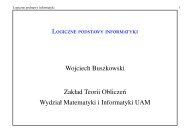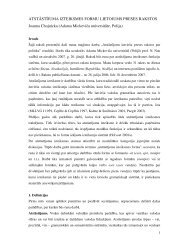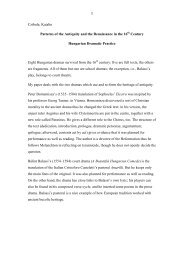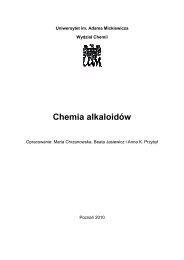Amir Weiner Getting to Know You
Amir Weiner Getting to Know You
Amir Weiner Getting to Know You
You also want an ePaper? Increase the reach of your titles
YUMPU automatically turns print PDFs into web optimized ePapers that Google loves.
GETTING TO KNOW YOU 33<br />
complexes and cities celebrating 1 May and the tercentennial of the Treaty of<br />
Pereiaslav that brought left-bank Ukraine in<strong>to</strong> the tsarist domain. A broken<br />
man, Halasa renounced his nationalist past. His confession, along with those<br />
of other captured underground leaders was published, and eventually he was<br />
pardoned and allowed <strong>to</strong> resume his education and professional career. 90<br />
By late 1951, the 2.6 million citizens of the Lithuanian Republic<br />
were blanketed by an army of nearly 28,000 MGB agents, residents, and<br />
informants, a force the size of a little over 1 percent of the population, not even<br />
including the MVD employees. The magnitude of these figures is even more<br />
remarkable when compared with other systems famous for pervasiveness and<br />
inflitration of their societies. At its numerical high point in 1989, the East<br />
German Stasi, the epi<strong>to</strong>me of ubiqui<strong>to</strong>us agency, consisted of 91,000 fulltime<br />
staff and 174,000 informants who moni<strong>to</strong>red 16.7 million citizens—<br />
that is, about 1.5 percent of the population. When the terri<strong>to</strong>rial size and<br />
population distribution are taken in<strong>to</strong> account, the omnipresence of the<br />
political police in the Soviet western frontier looks even more formidable. 91<br />
But it also embodied some of the fundamental weaknesses that plagued the<br />
Stalinist polity and had <strong>to</strong> be addressed even before the leader’s death.<br />
The Small Issue of Reliability<br />
How reliable was the information gathered by the Soviet security organs? This<br />
question plagues all state security services regardless of time and place, but<br />
as often is the case, the Soviets were somewhat distinct. The Soviet security<br />
agencies were aware of the imprecise nature of their information gathering—<br />
not least because of the language barrier in the non-Slavic republics, where<br />
agents’ lack of command of the indigenous languages made the infiltration of<br />
key cohorts rather difficult. 92<br />
90 Maria Savchyn Pyskir, Thousands of Roads: A Memoir of a <strong>You</strong>ng Woman’s Life in the Ukrainian<br />
Underground during and after World War II (Jefferson, NC: McFarland, 2001), 112–19, 127,<br />
181–84, 212–15, 219–30; citation on 191.<br />
91 LYA f. K-1, ap. 10, b. 144, l. 11. Figures on the Stasi are from Helmut Müller-<br />
Enbergs, Inoffizielle Mitarbeiter des Ministeriums für Staatssicherheit: Richtlinien und<br />
Durchführungsbestimmungen (Berlin: Chris<strong>to</strong>ph Links Verlag, 1996), 59; Jens Gieseke, Der<br />
Mielke-Konzern: Die Geschichte der Stasi, 1945–1990 (Munich: Deutsche Verlags-Anstalt,<br />
2006), 72.<br />
92 By the fall of 1956, the KGB acknowledged that barely 53% of its agents in Lithuania had<br />
mastered Lithuanian and severely restricted the surveillance of priests and former nationalists<br />
who were released from the Gulag (LYA f. 1771, ap. 190, b. 11, ll. 37, 40–41, 44–47).<br />
Interestingly, the East German Stasi, <strong>to</strong>o, estimated that in some districts barely 25% of the<br />
information supplied by informants was of operational value (Mike Dennis, The Stasi: Myth<br />
and Reality [London: Pearson, 2003], 103).


















